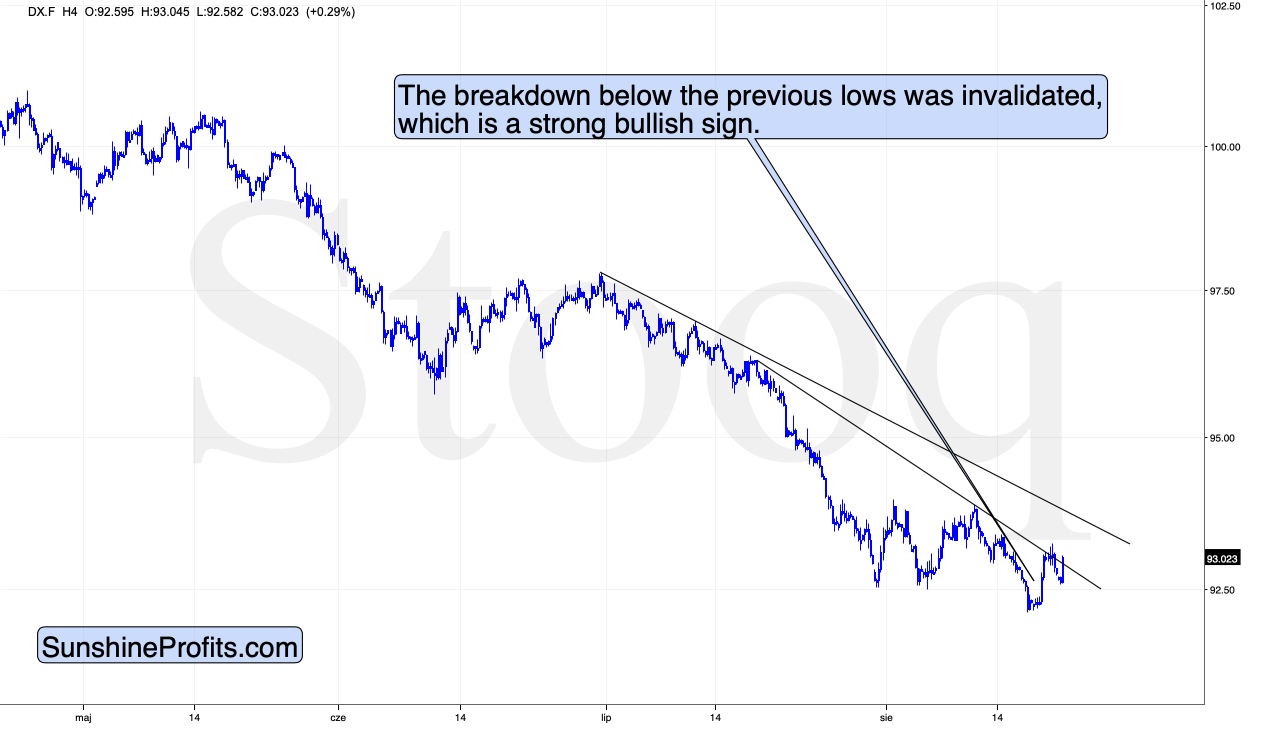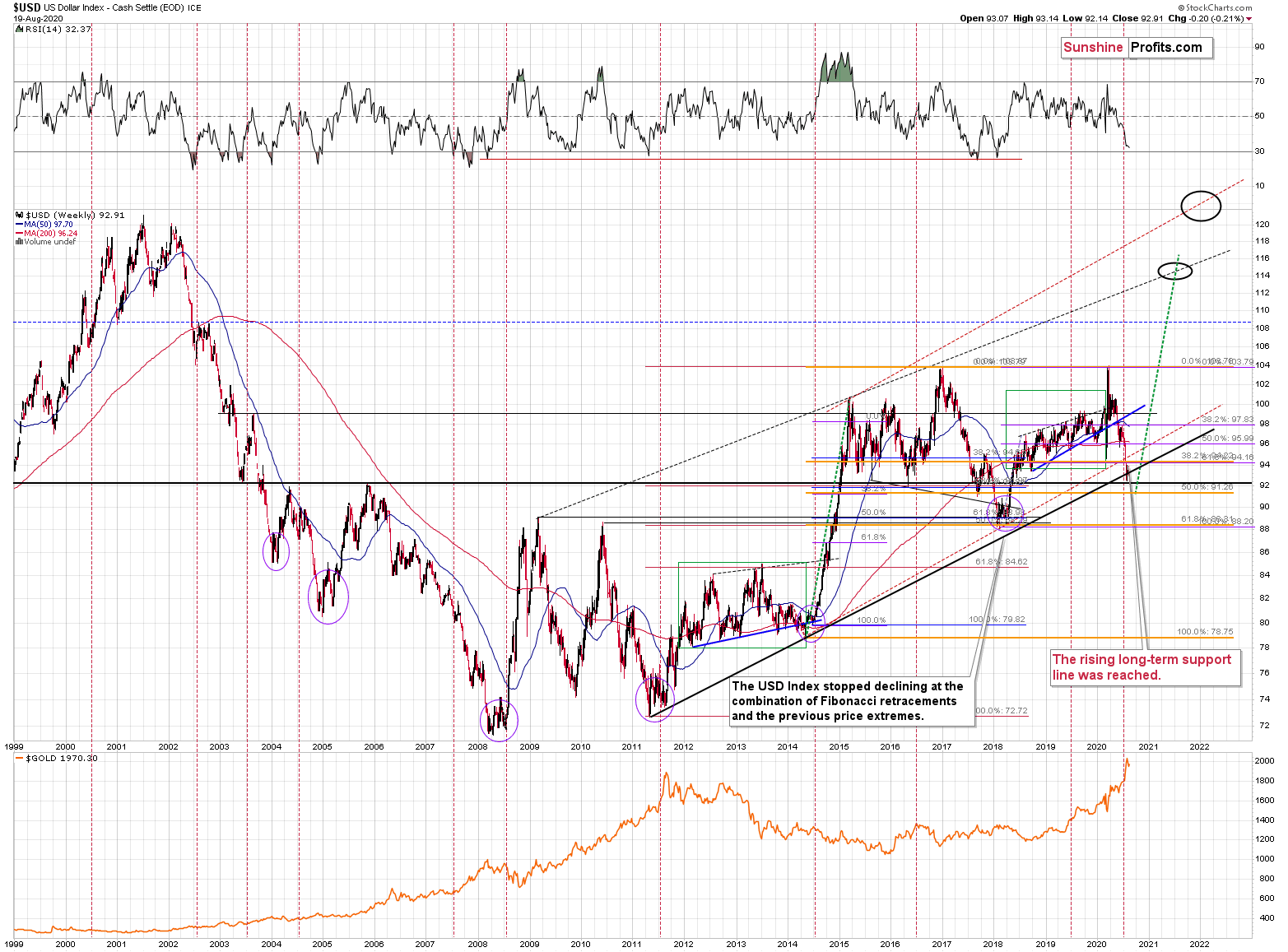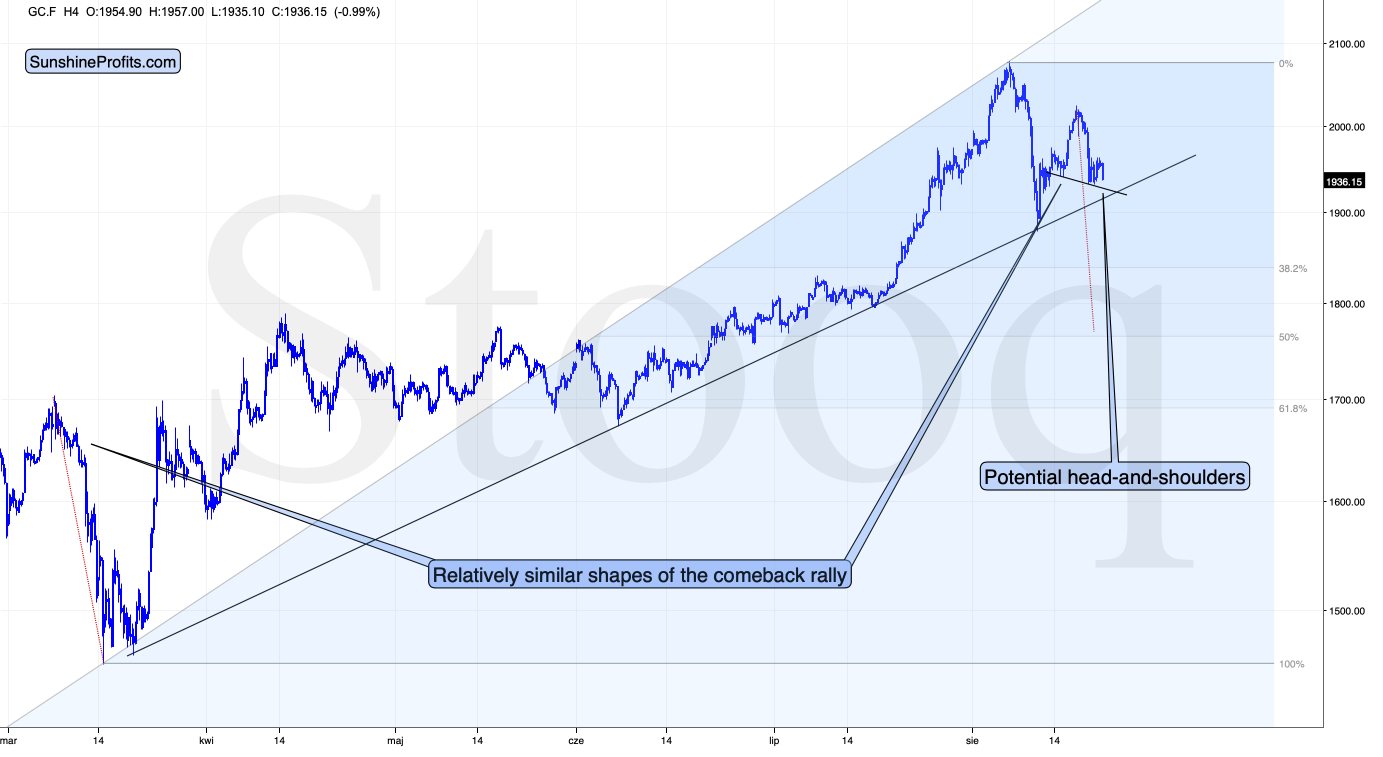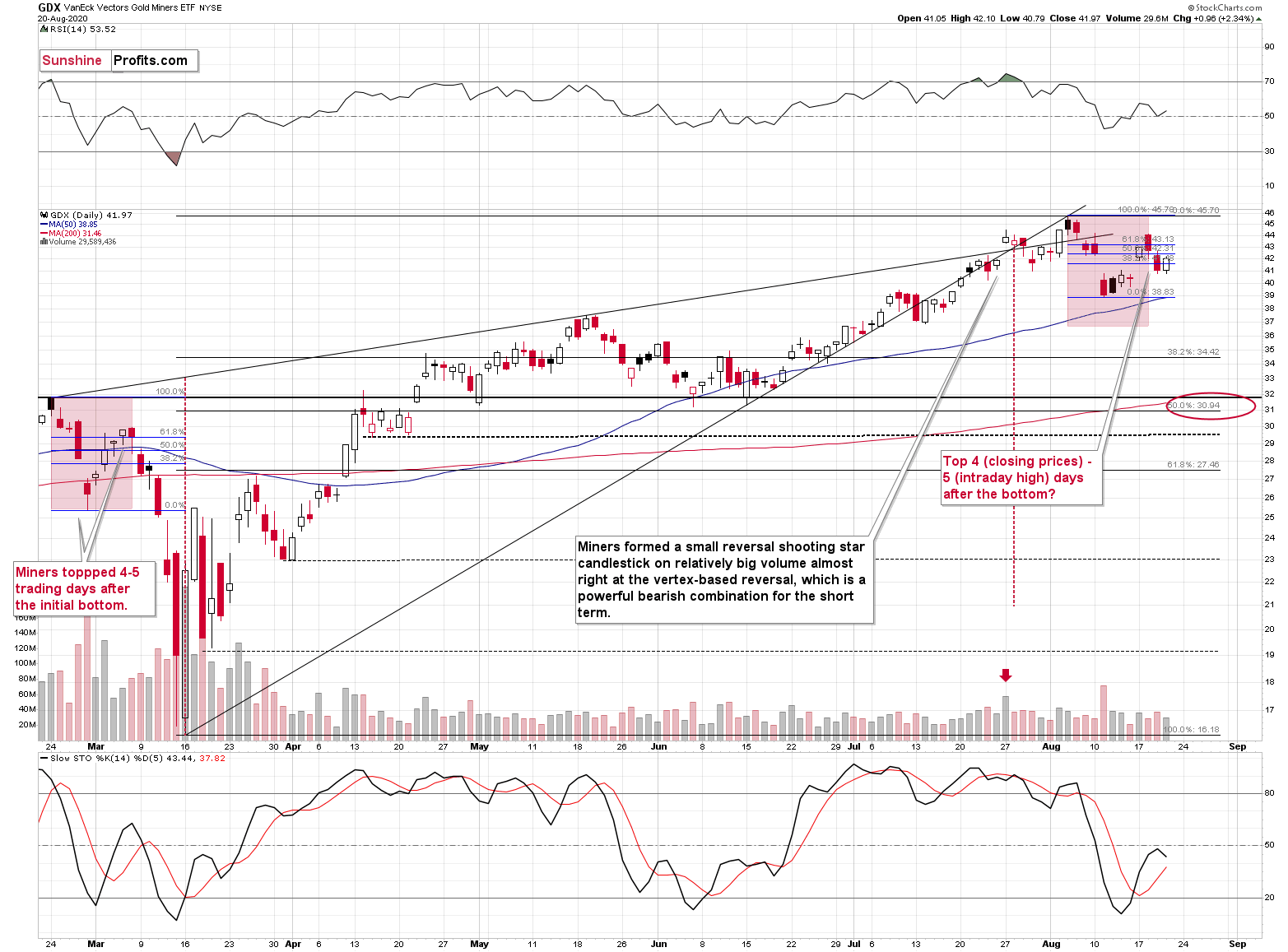Briefly: in our opinion, full (300% of the regular position size) speculative short positions in mining stocks are justified from the risk/reward point of view at the moment of publishing this Alert.
The situation in the precious metals market continues to evolve in the way we have been describing it in recent Alerts. In particular, the situation continues to be similar to what we saw in March. There are some differences (gold didn't move above the initial highs, but silver was relatively strong this time), but overall both: PMs and the USD Index appear to be repeating their performance to a significant extent.
Let's take a look at the latter.
After correcting briefly, the USD Index is once again moving higher and it just moved above its declining resistance line. This is a sign of strength and a confirmation that the bottom was indeed formed right before the USDX invalidated its breakdown below the July and early-August lows. In other words, our yesterday's comments remain up-to-date:
Ladies and gentlemen... The bottom in the USD Index appears to be finally in. The U.S. currency invalidated the breakdown below its previous lows and right now its testing the declining resistance line. The invalidation of the breakdown itself is a huge deal - we haven't seen anything like that in months. It's likely the short-term game-changer, especially that the USD Index at the same time invalidated the breakdown below the long-term rising support line visible on the below chart.
It seems that we will see a clear weekly reversal candlestick based on tomorrow's closing prices, which would then bode very well for the following week/s. And it would be very bearish for gold.
Then again, miners could bottom before gold does, just like they have done in March.
As far as gold is concerned, we wrote the following:
If the final pre-plunge top is already behind us, and gold declines similarly to how it had declined in March, then we could see the bottom as early as next week.
Also, moving back to the previous chart, please note that while miners declined quite visibly in the last two trading days, silver didn't. This is in perfect tune with what happened in March - silver's initial decline was relatively insignificant, and then silver caught up with vengeance, when miners' slide slowed down. We expect this to take place once again, and we plan to switch from our short positions in miners to short positions in silver - perhaps as early as this or next week.
Today, we would like to add that the shape of the current decline is somewhat similar to what we saw in March - gold paused after the initial part of the decline. This time, it's taking a slightly different form though. Namely, it's taking form of the head-and-shoulders top formation. Based on the size of the head of the formation, once gold breaks below the neckline (at about $1,925), it would be likely to decline to at least $1,840 or so. This would be in perfect tune with 38.2% Fibonacci retracement based on the entire March - August rally. Consequently, a brief rebound from this level would be quite likely, before the decline continues.
The mining stocks are also performing very similarly to what they've done in March. Back then, on the third day of the decline - on March 10th - we saw a small daily upswing, which was just a daily pause right before the biggest part of the move.
We saw the same thing yesterday. The GDX ETF moved a bit higher and it was the third day of the decline.
Just like what we saw on March 10th, GDX moved higher on volume that was slightly lower than what we saw on the previous trading day.
The implications remain very bearish.
Overview of the Upcoming Decline
As far as the current overview of the upcoming decline is concerned, I think that it has already begun, at least in case of the mining stocks. It's still relatively unclear if gold makes another attempt to move to new highs before plunging below $1,800, but it now appears more likely that it won't.
During the final part of the slide, we expect silver to decline more than miners. That would be in tune with how the markets initially reacted to the Covid-19 threat.
The impact of all the new rounds of money printing in the U.S. and Europe on the precious metals prices is very positive in the long run, but it doesn't make the short-term decline unlikely. In the very near term, markets can and do get ahead of themselves and then need to decline - sometimes very profoundly - before continuing their upward march.
Summary
Summing up, it seems that after reversing $4 above our upside target, gold has finally topped. The opposite appears likely in case of the USD Index, which just invalidated its breakdown below the previous lows. This, plus the invalidation of the breakout in the S&P 500 Index creates a very bearish environment for the precious metals market, especially for the mining stocks.
Naturally, everyone's trading is their responsibility, but in our opinion, if there ever was a time to either enter a short position in the miners or to increase its size if it wasn't already sizable, it's now. We made money on the March decline and on the March rebound, and it seems that another massive slide is about to start. When everyone is on one side of the boat, it's a good idea to be on the other side, and the Gold Miners Bullish Percent Index literally indicates that this is the case with mining stocks.
After the sell-off (that takes gold to about $1,700 or lower), we expect the precious metals to rally significantly. The final decline might take as little as 1-6 weeks, so it's important to stay alert to any changes.
Most importantly - stay healthy and safe. We made a lot of money on the March decline and the subsequent rebound (its initial part) price moves (and we'll likely make much more in the following weeks and months), but you have to be healthy to really enjoy the results.
As always, we'll keep you - our subscribers - informed.
To summarize:
Trading capital (supplementary part of the portfolio; our opinion): Full speculative short positions (300% of the full position) in mining stocks is justified from the risk to reward point of view with the following binding exit profit-take price levels:
Senior mining stocks (price levels for the GDX ETF): binding profit-take exit price: $32.02; stop-loss: none (the volatility is too big to justify a SL order in case of this particular trade); binding profit-take level for the DUST ETF: $28.73; stop-loss for the DUST ETF: none (the volatility is too big to justify a SL order in case of this particular trade)
Junior mining stocks (price levels for the GDXJ ETF): binding profit-take exit price: $42.72; stop-loss: none (the volatility is too big to justify a SL order in case of this particular trade); binding profit-take level for the JDST ETF: $21.22; stop-loss for the JDST ETF: none (the volatility is too big to justify a SL order in case of this particular trade)
For-your-information targets (our opinion; we continue to think that mining stocks are the preferred way of taking advantage of the upcoming price move, but if for whatever reason one wants / has to use silver or gold for this trade, we are providing the details anyway. In our view, silver has greater potential than gold does):
Silver futures downside profit-take exit price: unclear at this time - initially, it might be a good idea to exit, when gold moves to $1,703.
Gold futures downside profit-take exit price: $1,703
Long-term capital (core part of the portfolio; our opinion): No positions (in other words: cash
Insurance capital (core part of the portfolio; our opinion): Full position
Whether you already subscribed or not, we encourage you to find out how to make the most of our alerts and read our replies to the most common alert-and-gold-trading-related-questions.
Please note that the in the trading section we describe the situation for the day that the alert is posted. In other words, it we are writing about a speculative position, it means that it is up-to-date on the day it was posted. We are also featuring the initial target prices, so that you can decide whether keeping a position on a given day is something that is in tune with your approach (some moves are too small for medium-term traders and some might appear too big for day-traders).
Plus, you might want to read why our stop-loss orders are usually relatively far from the current price.
Please note that a full position doesn't mean using all of the capital for a given trade. You will find details on our thoughts on gold portfolio structuring in the Key Insights section on our website.
As a reminder - "initial target price" means exactly that - an "initial" one, it's not a price level at which we suggest closing positions. If this becomes the case (like it did in the previous trade) we will refer to these levels as levels of exit orders (exactly as we've done previously). Stop-loss levels, however, are naturally not "initial", but something that, in our opinion, might be entered as an order.
Since it is impossible to synchronize target prices and stop-loss levels for all the ETFs and ETNs with the main markets that we provide these levels for (gold, silver and mining stocks - the GDX ETF), the stop-loss levels and target prices for other ETNs and ETF (among other: UGLD, DGLD, USLV, DSLV, NUGT, DUST, JNUG, JDST) are provided as supplementary, and not as "final". This means that if a stop-loss or a target level is reached for any of the "additional instruments" (DGLD for instance), but not for the "main instrument" (gold in this case), we will view positions in both gold and DGLD as still open and the stop-loss for DGLD would have to be moved lower. On the other hand, if gold moves to a stop-loss level but DGLD doesn't, then we will view both positions (in gold and DGLD) as closed. In other words, since it's not possible to be 100% certain that each related instrument moves to a given level when the underlying instrument does, we can't provide levels that would be binding. The levels that we do provide are our best estimate of the levels that will correspond to the levels in the underlying assets, but it will be the underlying assets that one will need to focus on regarding the signs pointing to closing a given position or keeping it open. We might adjust the levels in the "additional instruments" without adjusting the levels in the "main instruments", which will simply mean that we have improved our estimation of these levels, not that we changed our outlook on the markets. We are already working on a tool that would update these levels on a daily basis for the most popular ETFs, ETNs and individual mining stocks.
Our preferred ways to invest in and to trade gold along with the reasoning can be found in the how to buy gold section. Additionally, our preferred ETFs and ETNs can be found in our Gold & Silver ETF Ranking.
As a reminder, Gold & Silver Trading Alerts are posted before or on each trading day (we usually post them before the opening bell, but we don't promise doing that each day). If there's anything urgent, we will send you an additional small alert before posting the main one.
Thank you.
Sincerely,
Przemyslaw Radomski, CFA
Editor-in-chief, Gold & Silver Fund Manager







